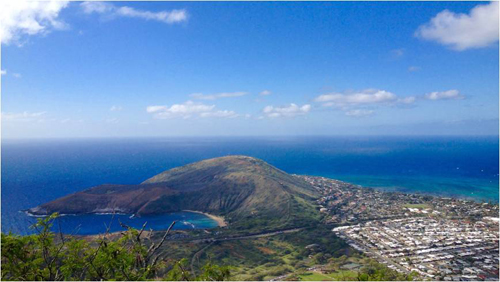Formation Mechanisms of the Equatorial Pacific SST Warming Pattern
Date:2015-12-04
The warming patterns of equatorial Pacific SST due to rising greenhouse gas concentrations is one of the most important problems in projecting regional climate change. Two well-known features of such warming patterns have been obtained through previous studies: the zonal El Ni?o-like pattern and the meridional equatorial-peak warming (EPW) pattern. However, the nature of the mechanisms involved in the formation of these warming patterns remains controversial. Based on CMIP5 outputs, Dr. HUANG Ping and his PhD student, Mr. YING Jun, from the Institute of Atmospheric Physics, Chinese Academy of Sciences, evaluated several of the mechanisms proposed in previous studies, and their resultant paper was recently accepted for publication in Advances in Atmospheric Sciences.

(Photo taken in Hawaii by Xi Cao in 2013)
For the El Nino-like pattern, surface energy budget analyses reveal that the effect of climatological evaporation plays a major role, while the cloud–shortwave-radiation–SST feedback and weakened Walker circulation play relatively small roles. “On the contrary, the effect of the ocean dynamical thermostat plays a major negative role, damping the El Nino-like pattern formation,” Dr. Huang observed.
For the meridional EPW pattern, the dominant role of the climatological latent heat flux is also apparent in the MME (multi-model ensemble) of the CMIP5 models. Nevertheless, some of the mechanisms evaluated in the present study are different from those in previous studies. The changes in the zonal heat transport due to the weakened Walker circulation make a considerable positive contribution to the EPW pattern. Moreover, the effect of changes in shortwave radiation damps the EPW pattern, while the effect of surface wind speed mainly influences the off-equatorial patterns.
Dr. Huang concludes by explaining: “It is important to note that this study is only based on the MME of 32 CMIP5 models’ outputs. However, the inter-model spread in the equatorial Pacific SST warming pattern is quite large in current CMIP models, with great impact on the uncertainties in projecting regional climate changes. This study is therefore a solid foundation for investigating the mechanisms of the uncertainties in the equatorial Pacific SST warming pattern in the future.”
Reference
Ying, J., P. Huang, and R. H. Huang, 2016: Evaluating the formation mechanisms of the equatorial Pacific SST warming pattern in CMIP5 models. Adv. Atmos. Sci., 33, in press. http://159.226.119.58/aas/EN/10.1007/s00376-015-5184-6
Contact:
Dr. HUANG Ping, huangping@mail.iap.ac.cn
